
Termites are a group of detritophagous eusocial insects which consume a wide variety of decaying plant material, generally in the form of wood, leaf litter, and soil humus. They are distinguished by their moniliform antennae and the soft-bodied and often unpigmented worker caste for which they have been commonly termed "white ants"; however, they are not ants, to which they are only distantly related. About 2,972 extant species are currently described, 2,105 of which are members of the family Termitidae.
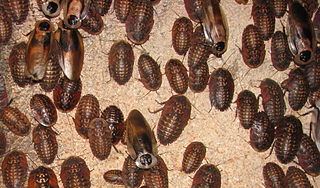
Giant cockroaches, or blaberids, are the second-largest cockroach family by number of species. Mostly distributed in warmer climates worldwide, this family is based on the American genus Blaberus, but much of the diversity is also found in Africa and Asia.

Blattidae is a cockroach family in the order Blattodea containing several of the most common household cockroaches. Notable species include:

Ectobiidae is a family of the order Blattodea (cockroaches). This family contains many of the smaller common household pest cockroaches, among others. They are sometimes called wood cockroaches. A few notable species include:

Cockroaches are insects belonging to the order Blattodea (Blattaria). About 30 cockroach species out of 4,600 are associated with human habitats. Some species are well-known pests.

Odontotaenius disjunctus, the patent-leather beetle or horned passalus, is a saproxylic beetle in the family Passalidae which can grow to just over an inch-and-a-half long, weigh 1-2 grams and are capable of pulling 50 times their own weight. They have been used to study several aspects of general family characteristics since the early 1900s but remain a relatively unknown species within the diverse Coleoptera order.

The giant burrowing cockroach is also known as the rhinoceros cockroach, and Queensland giant cockroach. These cockroaches are native to Australia and mostly found in tropical and subtropical parts of Queensland. They are the world's heaviest species of cockroach and can weigh up to 30-35 grams and measure up to 7.5-8 cm (3.1 in) in length. It is a member of the family Blaberidae, which contains hundreds of species. It is part of the blaberid subfamily Geoscapheinae. It is prominent in the wild and can also be sold and kept as a pet.

The death's head cockroach is a species of cockroach belonging to the family Blaberidae. It is often confused with the discoid cockroach, Blaberus discoidalis, due to its similar appearance. It is distinguished by jet black cloak-like marking on its wings and a skull-shaped, amber/black marking on its pronotum. The name death's head comes from the markings on the top of the pronotum: "cranii", which is Latin for "of the head", and "fer", meaning "carry" or "carrier". Due to their unique appearance and certain characteristics, they make an easy to care for pet or display insect for entomologists and hobbyists.
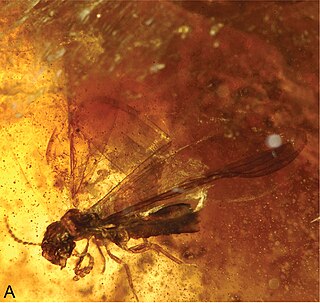
Termitidae is the largest family of termites consisting of 2,105 described species of which are commonly known as the higher termites. They are evolutionarily the most specialised termite group, with their highly compartmentalized hindgut lacking the flagellated protozoans common to "lower termites", which are instead replaced by bacteria and archaea. Whereas lower termites are restricted mostly to woody tissue, higher termites have diverse diets consisting of wood, grass, leaf litter, fungi, lichen, faeces, humus and soil. Around 60% of species rely on soil-feeding alone.

Diploptera, occasionally called beetle cockroaches, is a genus of blaberid cockroaches in the monotypic subfamily Diplopterinae. Cockroaches of this genus resemble beetles, with hardened tegmina and cross-folded hindwings. They live in tropical forests in South China and Southeast Asia, and Pacific islands including Hawaii. They are viviparous cockroaches and are therefore used for insect endocrinological studies.

Drymaplaneta semivitta is a species of cockroach native to Australia and introduced to New Zealand. In New Zealand, it is known as the Gisborne cockroach, after the city of Gisborne where it was first discovered in the country. It has also been claimed to have first appeared in Tauranga in 1954, probably arriving on a log shipment.

Panchlora is a genus of cockroaches in the subfamily Panchlorinae, erected by Hermann Burmeister in 1838. Species are mostly found in the Americas and Africa. Most species in this genus are green in colour, but some are cream or grey.

Diploptera punctata, the Pacific beetle cockroach, is a species of cockroach in the family Blaberidae and subfamily Diplopterinae. It is one of the few cockroach species that is viviparous. Adults are chemically defended, having a modified tracheal gland and spiracle on each side which squirts quinones which can poison or discourage a predator.
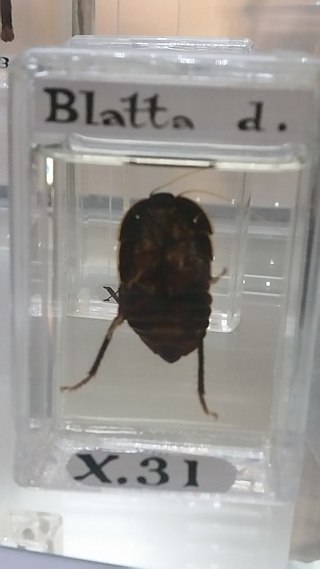
Calolampra elegans is a species of cockroach in the family Blaberidae. It is found in Queensland, Australia.

Podoscirtinae is a subfamily of crickets in the family Gryllidae.
Salganea is a genus of South East Asian cockroaches in the subfamily Panesthiinae, erected by Carl Stål in 1877.
Saccinobaculus is a genus of unicellular eukaryotes that resides in the hindgut of the wood-feeding cockroach Cryptocercus punctulatus. This genus is known for its distinctive movement that resembles a snake trashing in a bag. The genus is involved in the digestion of wood materials within its insect-host and is vertically transmitted to insect progeny. The genus is the part of the family Saccinobaculidae.
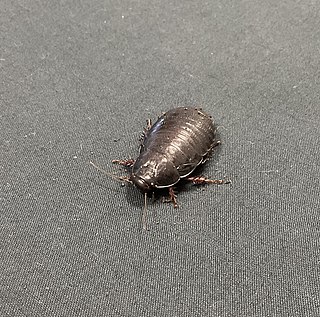
Panesthia lata, the Lord Howe Island wood-feeding cockroach or Lord Howe Island cockroach, is a large, wingless cockroach species endemic to the Lord Howe Island Group in the Tasman Sea.
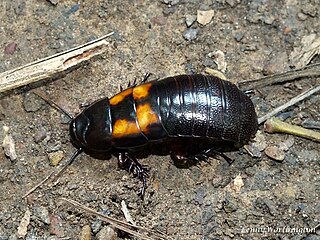
Panesthia is a large genus of burrowing giant cockroach in the subfamily Panesthiinae. It is subsocial and its species are mainly found in Southeast Asia, coastal East Asia, Australasia, and Indo-Malaysia.
















